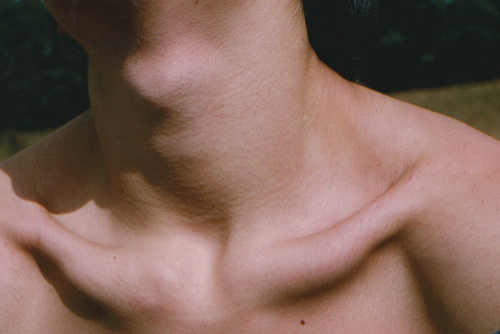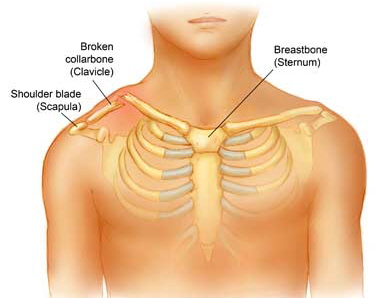Why Does My Collar Bone Stick Out?
The protrusion of your collar bone, also known as the clavicle, can be influenced by various factors. It’s often a natural variation in anatomy, impacted by genetics and skeletal structure. Posture plays a role too, if you tend to slouch or have certain skeletal alignments, your collar bone may appear more pronounced.
In some cases, medical conditions can contribute to this phenomenon. While collar bone protrusion is usually harmless, if you have concerns about appearance or experience discomfort, it’s advisable to consult with a healthcare professional.
What is the Anatomy of the Collar Bone?

The collarbone, also known as the clavicle, is a long, slender bone that connects the sternum (breastbone) to the shoulder blade on each side, forming part of the shoulder girdle. It plays an important role in supporting the arm and facilitating a wide range of arm movements.
The collarbone is typically “S”-shaped and slightly curved. It has two main ends: the sternal end, which articulates with the sternum, and the acromial end, which connects to the shoulder blade (acromion process). The shaft of the collarbone has a smooth, cylindrical shape.
Several key ligaments and muscles surround the collarbone, providing stability and allowing for coordinated movement with other bones in the shoulder.
Normal Variations in Collar Bone Appearance
Genetic Influences: The shape and curvature of the collarbone can vary among individuals due to genetic factors. Some may have a more prominent or curved collarbone based on their family history.
Body Composition: Individuals with lower levels of body fat may exhibit a more visible collarbone. Reduced soft tissue coverage allows the bone’s natural contours to be more apparent.
Postural Effects: Posture can impact the appearance of the collarbone. Poor posture, such as slouching, may contribute to the prominence of the collarbone or alter its alignment.
Muscle Development: The appearance of the collarbone can be influenced by the development and distribution of muscles around the shoulder and upper chest. Underdeveloped or unevenly developed muscles may contribute to a more noticeable collarbone.
What Are The Causes of Collar Bone Protrusion?

Collar bone protrusion can be caused by a combination of genetic factors, leading to natural variations in bone structure.
Additionally, poor posture, skeletal misalignment, muscle imbalances, skeletal abnormalities, and past trauma or injuries to the collarbone can contribute to its protruding appearance.
Genetics and Natural Variations
Genetics plays a significant role in determining bone structure, including the collar bone. Familial traits can influence the shape and prominence of the collarbone, leading to natural variations among individuals. Some may inherently have a more pronounced or differently shaped collar bone due to their genetic makeup.
Posture and Skeletal Alignment
Protrusion of the collarbone can be influenced by posture and skeletal alignment. Poor posture, such as slouching or rounded shoulders, may exaggerate the appearance of a sticking-out collarbone. The alignment of the spine, shoulder blades, and the clavicle itself can contribute to how prominent the collarbone appears.
Medical Conditions Contributing to Protrusion
Muscle Imbalance: Conditions that result in muscle imbalances around the shoulder girdle can affect the alignment of the collarbone, potentially leading to protrusion. Weakness or tightness in certain muscles may contribute to the observed prominence.
Skeletal Abnormalities: Structural anomalies or abnormalities in the bones, joints, or connective tissues around the collarbone can lead to protrusion. These may include congenital conditions or acquired issues affecting the skeletal framework.
Trauma or Injury: Previous injuries or trauma to the collarbone or surrounding areas can influence its appearance. Fractures or dislocations, even if healed, may cause lasting changes in the bone’s shape.
What is the treatment for a broken collarbone?

The treatment for a broken collarbone, also known as a clavicle fracture, depends on the severity of the fracture. In many cases, conservative measures are effective
Immobilization
A common approach for managing a broken collarbone involves immobilizing the affected arm with a sling. This helps reduce movement around the fracture site, promoting healing.
The duration of sling use varies based on the severity of the fracture and how well the bone is healing. It may range from a few weeks to several weeks.
Pain Management
Non-prescription pain relievers, such as acetaminophen or ibuprofen, may be recommended to alleviate pain and reduce inflammation.
In cases of more intense pain, healthcare providers may prescribe stronger pain medications for a limited period.
Physical Therapy
Initiation: Once the bone shows signs of healing, a healthcare provider may recommend physical therapy.
Exercises: Physical therapy exercises focus on restoring strength, flexibility, and range of motion in the shoulder and arm. This helps prevent stiffness and enhances overall recovery.
Surgical Intervention
In certain cases, especially if the collarbone is significantly displaced or if the fracture involves multiple pieces, surgery may be considered.
Surgeons may use plates, screws, or pins to realign and stabilize the fractured collarbone. This hardware helps maintain proper alignment during the healing process.
Follow-Up Care
Regardless of the chosen treatment approach, regular follow-up appointments with a healthcare provider are essential. X-rays may be taken periodically to assess the progress of bone healing.
Treatment plans may be adjusted based on how well the collarbone is healing and the individual’s response to the chosen interventions.
When to Seek Medical Advice?
Normal vs. Abnormal Protrusion
Distinguishing between normal and abnormal collarbone protrusion involves considering various factors. Normal protrusion often results from genetic factors, body composition, or posture, and is typically not associated with pain or discomfort.
Abnormal protrusion may be characterized by sudden changes, persistent pain, or asymmetry. If the protrusion is noticeably different from one side to the other, or if it is accompanied by other concerning symptoms, it’s advisable to seek medical advice for a thorough evaluation.
Signs Indicating Potential Health Issues
Certain signs may indicate potential health issues related to collarbone protrusion. Persistent pain, tenderness, or swelling around the collarbone area could suggest an underlying problem, such as an injury, inflammation, or infection.
Additionally, if the protrusion is accompanied by restricted arm movement, numbness, tingling, or weakness in the arm, it may signal nerve or vascular involvement.
Any unexplained weight loss or fatigue should also be taken seriously, as it could be indicative of an underlying medical condition. Recognizing these signs is crucial in determining when to seek prompt medical attention.
Importance of Professional Evaluation
Professional evaluation is paramount when dealing with collarbone concerns, especially if there are uncertainties about the cause or if symptoms are present.
Healthcare professionals, including orthopedic specialists or general practitioners, can conduct a thorough physical examination, review medical history, and perform diagnostic tests such as X-rays or imaging studies.
This comprehensive evaluation helps determine the underlying cause of collarbone protrusion and guides appropriate management. Early detection of potential health issues can prevent complications and ensure timely intervention.
If there are any doubts or if symptoms persist, seeking medical advice promptly is the key to understanding and addressing the root cause of collarbone protrusion.
FAQ
What does it mean if your collar bones pop out?
Sometimes, collarbone popping is just your joints adjusting, similar to cracking your knuckles. It’s usually harmless. However, persistent pain or discomfort might indicate an underlying issue, so it’s best to consult with a healthcare professional.
What does it mean if your collarbone is very visible?
A highly visible collarbone is often a result of genetics, body fat percentage, or muscle mass. It’s generally not a cause for concern unless it’s accompanied by other health symptoms.
Is a visible collarbone unhealthy?
Not necessarily. Some people naturally have more prominent collarbones. However, extreme weight loss or low body fat percentage can make collarbones more visible. If you’re concerned about your health, consult with a healthcare provider for personalized advice.
What is the attractive beauty bone in a female?
The collarbone is often considered an attractive beauty bone in females. Its subtle prominence can enhance the elegance of the neck and shoulders. Beauty standards vary, so always celebrate what makes you feel confident and beautiful.
Why am I skinny but my collar bones don’t show?
Visible collarbones depend on various factors, including genetics and muscle mass. Even if you’re skinny, your body composition may not emphasize your collarbones. Building muscle through targeted exercises might help enhance their visibility.
What should collarbones look like?
Collarbones vary in appearance, and there’s no one-size-fits-all. Ideally, they should align symmetrically on each side of your neck and shoulders. Embrace the natural shape and uniqueness of your collarbones.
Can exercise make collarbones visible?
Yes, targeted exercises that engage the shoulder and neck muscles can enhance the visibility of your collarbones. However, remember that individual results may vary, and it’s essential to maintain a balanced approach to exercise and nutrition for overall health.
Final words
To conclude, a protruding collar bone is often a natural aspect influenced by genetics and posture. While appearance concerns are common, it’s crucial to appreciate the diversity of body structures.
Most cases pose no health risks. If discomfort persists or concerns linger, seeking advice from a healthcare professional is recommended. Embrace the uniqueness of your collar bone, understand that it contributes to your individuality, and prioritize self-acceptance for a positive and confident self-image.







